Predicting customer satisfaction
Attributes X1 to X6 indicate the responses for each question and have values from 1 to 5 where the smaller number indicates less and the higher number indicates more towards the answer.
- X1 = my order was delivered on time
- X2 = contents of my order was as I expected
- X3 = I ordered everything I wanted to order
- X4 = I paid a good price for my order
- X5 = I am satisfied with my courier
- X6 = the app makes ordering easy for me
- Y = target attribute (Y) with values indicating 0 (unhappy) and 1 (happy) customers
import sys, os
import pandas as pd
import numpy as np
import matplotlib.pyplot as plt
import seaborn as sns
import warnings
from sklearn.tree import DecisionTreeClassifier
from sklearn.model_selection import train_test_split
from sklearn.metrics import accuracy_score
from sklearn.tree import plot_tree
from sklearn.metrics import confusion_matrix
from sklearn.metrics import roc_curve, auc
from sklearn.metrics import precision_recall_curve
warnings.filterwarnings('ignore')
Let’s create a few helper functions.
def plot_confusion_matrix(y_test, y_pred, var):
"""
This function plots a confusion matrix given a set of true labels and predicted labels.
Parameters
----------
y_test : array-like
The true labels.
y_pred : array-like
The predicted labels.
"""
cm = confusion_matrix(y_test, y_pred)
sns.heatmap(cm, annot=True, fmt='d', cmap='Blues')
plt.xlabel('Predicted')
plt.ylabel('Actual')
plt.show()
def plot_roc_curve(y_test, y_pred,var):
"""
This function plots a ROC curve given a set of true labels and predicted labels.
Parameters
----------
y_test : array-like
The true labels.
y_pred : array-like
The predicted labels.
"""
fpr, tpr, thresholds = roc_curve(y_test, y_pred)
roc_auc = auc(fpr, tpr)
plt.figure()
lw = 2
plt.plot(fpr, tpr, color='darkorange',
lw=lw, label='ROC curve (area = %0.2f)' % roc_auc)
plt.plot([0, 1], [0, 1], color='navy', lw=lw, linestyle='--')
plt.xlim([0.0, 1.0])
plt.ylim([0.0, 1.05])
plt.xlabel('False Positive Rate')
plt.ylabel('True Positive Rate')
plt.title('Receiver operating characteristic')
plt.legend(loc="lower right")
plt.show()
def plot_precision_recall_curve(y_test, y_pred,var):
"""
This function plots a precision-recall curve given a set of true labels and predicted labels.
Parameters
----------
y_test : array-like
The true labels.
y_pred : array-like
The predicted labels.
"""
precision, recall, thresholds = precision_recall_curve(y_test, y_pred)
plt.figure()
lw = 2
plt.plot(recall, precision, color='darkorange',
lw=lw, label='Precision-Recall curve')
plt.xlim([0.0, 1.0])
plt.ylim([0.0, 1.05])
plt.xlabel('Recall')
plt.ylabel('Precision')
plt.title('Precision-Recall curve')
plt.legend(loc="lower right")
plt.show()
Exploratory data analysis
df = pd.read_csv(os.path.abspath(os.path.join(os.getcwd(), './data','ACME-HappinessSurvey2020.csv')))
df.info()
Console output (1/1):
<class 'pandas.core.frame.DataFrame'>
RangeIndex: 126 entries, 0 to 125
Data columns (total 7 columns):
# Column Non-Null Count Dtype
--- ------ -------------- -----
0 Y 126 non-null int64
1 X1 126 non-null int64
2 X2 126 non-null int64
3 X3 126 non-null int64
4 X4 126 non-null int64
5 X5 126 non-null int64
6 X6 126 non-null int64
dtypes: int64(7)
memory usage: 7.0 KB
df.describe()
Console output (1/1):
.dataframe tbody tr th {
vertical-align: top;
}
.dataframe thead th {
text-align: right;
}
# Distribution of answers
fig, axs = plt.subplots(2, 3, figsize=(15, 10))
sns.distplot(df['X1'], ax=axs[0, 0])
axs[0, 0].set_title('my order was delivered on time')
sns.distplot(df['X2'], ax=axs[0, 1])
axs[0, 1].set_title('contents of my order was as I expected')
sns.distplot(df['X3'], ax=axs[0, 2])
axs[0, 2].set_title('I ordered everything I wanted to order')
sns.distplot(df['X4'], ax=axs[1, 0])
axs[1, 0].set_title('I paid a good price for my order')
sns.distplot(df['X5'], ax=axs[1, 1])
axs[1, 1].set_title('I am satisfied with my courier')
sns.distplot(df['X6'], ax=axs[1, 2])
axs[1, 2].set_title('the app makes ordering easy for me')
plt.show()
Console output (1/1):
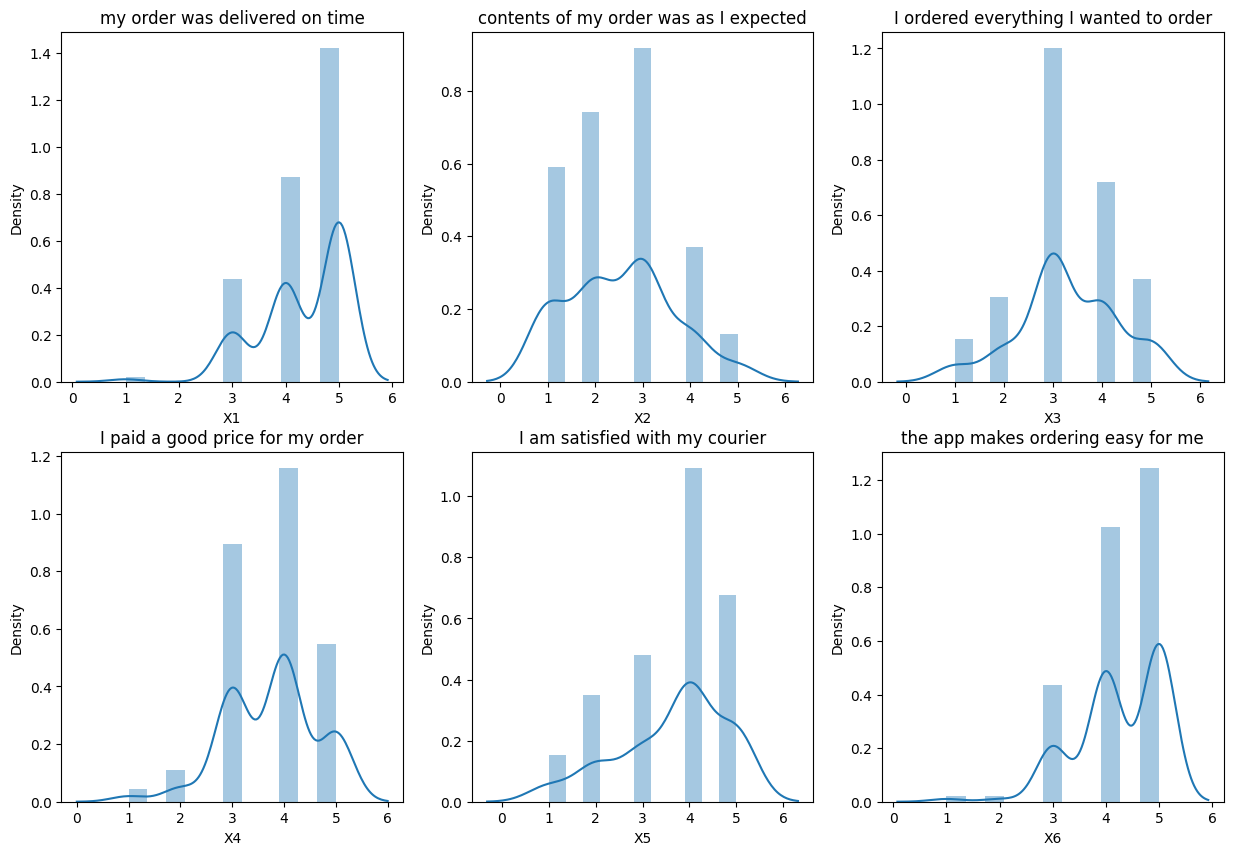
# Customer satisfaction
fig, axs = plt.subplots(1, 2, figsize=(15, 5))
sns.distplot(df['Y'], ax=axs[0])
axs[0].set_title('Customer satisfaction')
sns.countplot(df['Y'], ax=axs[1])
axs[1].set_title('Customer satisfaction')
plt.show()
Console output (1/1):

# Correlation matrix
corr = df.corr()
fig, ax = plt.subplots(figsize=(10, 10))
sns.heatmap(corr, annot=True, ax=ax)
plt.title('Correlation matrix')
plt.show()
Console output (1/1):
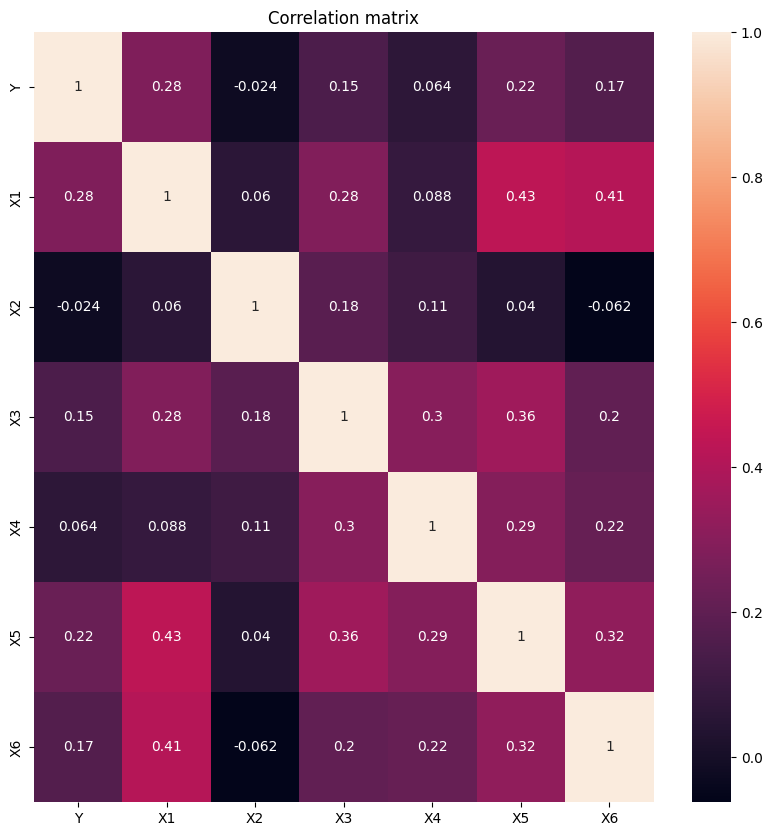
Initial prediction with DecisionTree
# Build a decision tree that predicts Y based on X1, X2, X3, X4, X5, X6
y = df['Y']
X = df.drop(['Y'], axis=1)
X_train, X_test, y_train, y_test = train_test_split(X, y, test_size=0.2, random_state=42)
clf = DecisionTreeClassifier(random_state=42)
clf.fit(X_train, y_train)
y_pred = clf.predict(X_test)
print('Accuracy: ', accuracy_score(y_test, y_pred))
Console output (1/1):
Accuracy: 0.6153846153846154
# Plot the decision tree
plt.figure(figsize=(20, 10))
plot_tree(clf, filled=True, rounded=True, feature_names=X.columns, class_names=['0', '1'])
plt.show()
Console output (1/1):
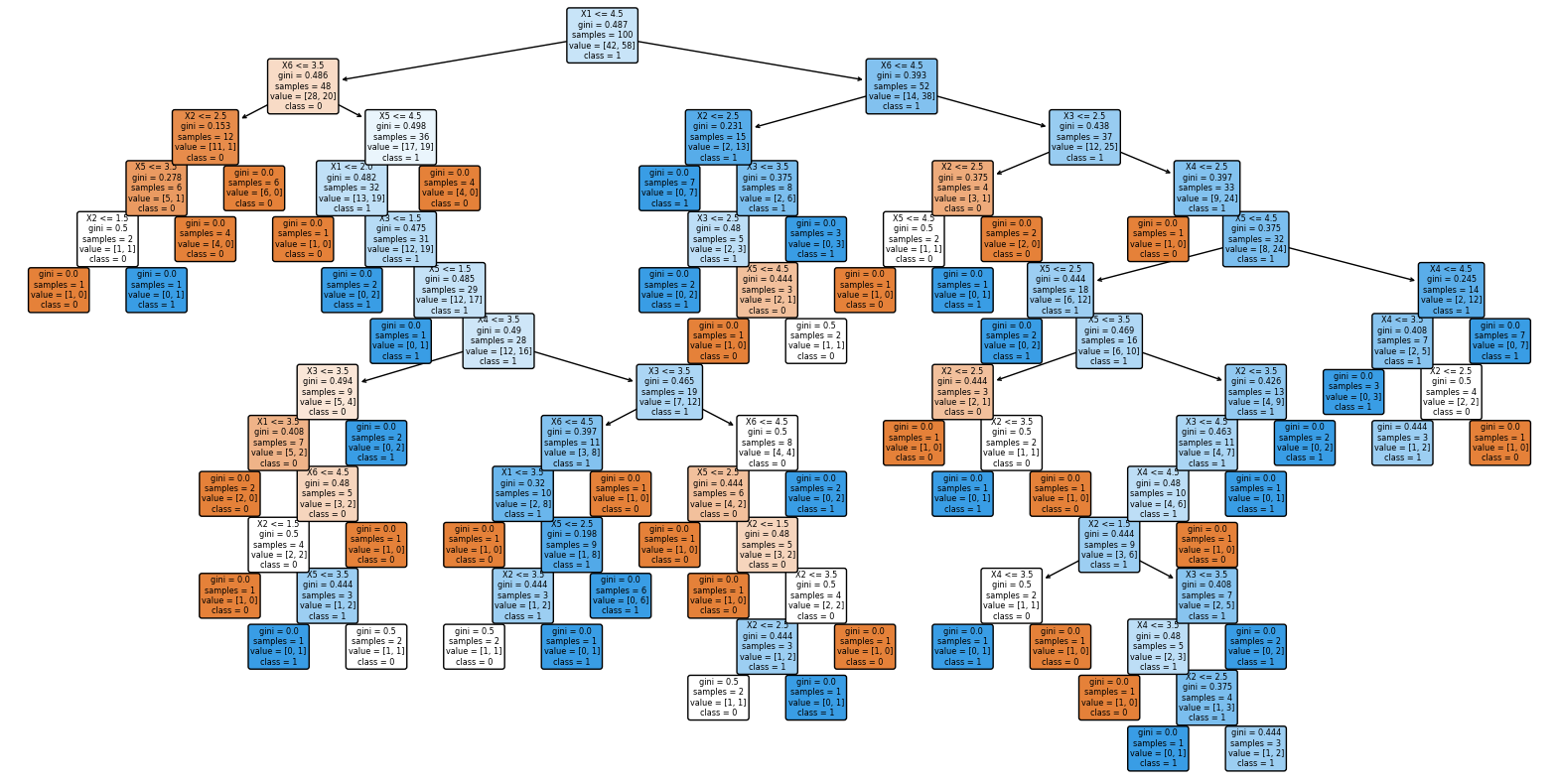
Prediction using XGboost
Let’s improve prediction accuracy while minimizing the number of parameters we use.
# use xgboost now
import xgboost as xgb
from xgboost import plot_importance
# Build a decision tree that predicts Y based on X1, X2, X3, X4, X5, X6
y = df['Y']
X = df.drop(['Y'], axis=1)
X_train, X_test, y_train, y_test = train_test_split(X, y, test_size=0.2, random_state=42)
xgb_clf = xgb.XGBClassifier(random_state=42)
xgb_clf.fit(X_train, y_train)
y_pred = xgb_clf.predict(X_test)
print('Accuracy: ', accuracy_score(y_test, y_pred))
Console output (1/1):
Accuracy: 0.6538461538461539
Identifying key parameters
import itertools
import xgboost as xgb
from sklearn.metrics import accuracy_score
from sklearn.model_selection import train_test_split
# Define the features to experiment with
features = ['X1', 'X2', 'X3', 'X4', 'X5', 'X6']
# Get all possible combinations of features
feature_combinations = []
for i in range(len(features)):
feature_combinations += list(itertools.combinations(features, i+1))
# Split the data into training and testing sets
y = df['Y']
X = df.drop(['Y'], axis=1)
X_train, X_test, y_train, y_test = train_test_split(X, y, test_size=0.2, random_state=42)
# Train and test the model using different feature combinations
for feature_set in feature_combinations:
# Get the features to use
X_train_subset = X_train[list(feature_set)]
X_test_subset = X_test[list(feature_set)]
# Train the model
xgb_clf = xgb.XGBClassifier(random_state=42)
xgb_clf.fit(X_train_subset, y_train)
# Test the model
y_pred = xgb_clf.predict(X_test_subset)
accuracy = accuracy_score(y_test, y_pred)
# Print the results
if accuracy > 0.73:
print('Features: {}, Accuracy: {}'.format(feature_set, accuracy))
Console output (1/1):
Features: ('X1', 'X5'), Accuracy: 0.7307692307692307
Features: ('X1', 'X2', 'X5'), Accuracy: 0.7692307692307693
Features: ('X1', 'X2', 'X4', 'X5'), Accuracy: 0.7692307692307693
# Set up X and y
y = df['Y']
X = df[['X1', 'X2','X5']]
# Split the data into training and testing sets
X_train, X_test, y_train, y_test = train_test_split(X, y, test_size=0.2, random_state=42)
# Train the model
xgb_clf = xgb.XGBClassifier(random_state=42)
xgb_clf.fit(X_train, y_train)
# Test the model
y_pred = xgb_clf.predict(X_test)
# Print the results
print('Accuracy: ', accuracy_score(y_test, y_pred))
from sklearn.metrics import classification_report
# Print the classification report
print(classification_report(y_test, y_pred))
Console output (1/1):
Accuracy: 0.7692307692307693
precision recall f1-score support
0 0.80 0.80 0.80 15
1 0.73 0.73 0.73 11
accuracy 0.77 26
macro avg 0.76 0.76 0.76 26
weighted avg 0.77 0.77 0.77 26
# Plot the feature importance
fig = plot_importance(xgb_clf)
Console output (1/1):
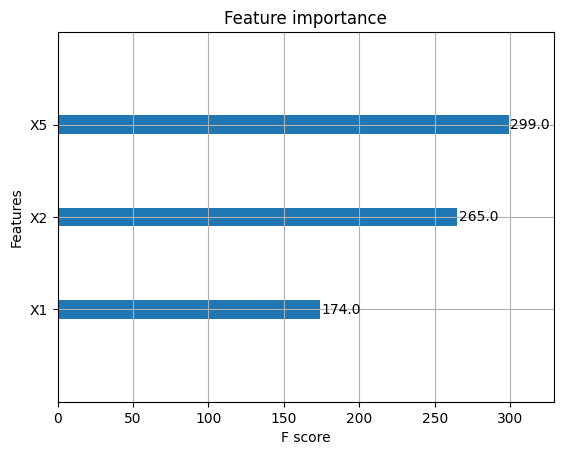
# Plot the ROC curve
plot_roc_curve(y_test, y_pred, 'X1_X2X5')
Console output (1/1):
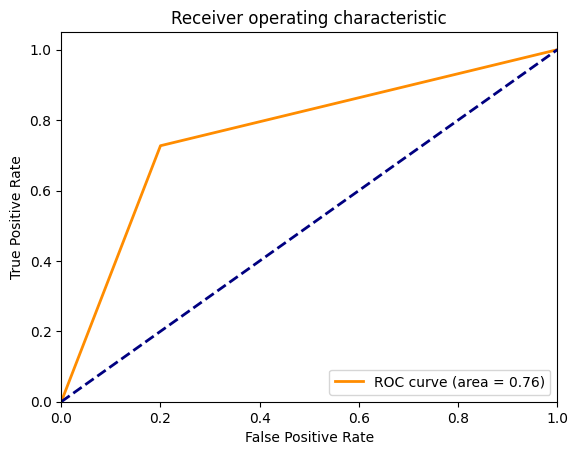
# Plot the precision-recall curve
plot_precision_recall_curve(y_test, y_pred, 'X1_X2_X5')
Console output (1/1):
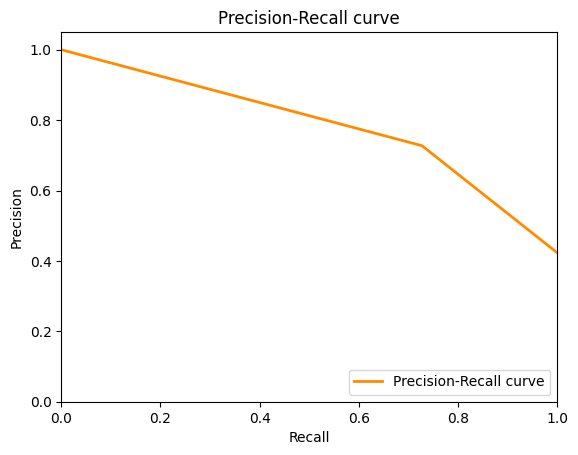
# Plot the confusion matrix
plot_confusion_matrix(y_test, y_pred, "X1_X2_X5")
Console output (1/1):
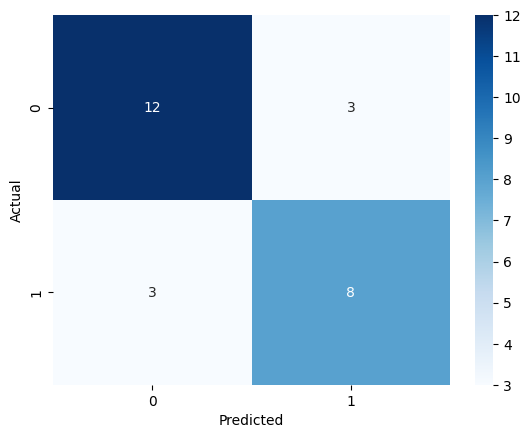
Conclusion
The following parameters seemed to have the most impact predicting customer satisfaction
- X5 = I am satisfied with my courier
- X2 = contents of my order was as I expected
- X1 = my order was delivered on time
Adding the following parameter has a slightly better performance (ROC curve)
- X4 = I paid a good price for my order
Adding the following parameters decreased performance
- X3 = I ordered everything I wanted to order
- X6 = the app makes ordering easy for me